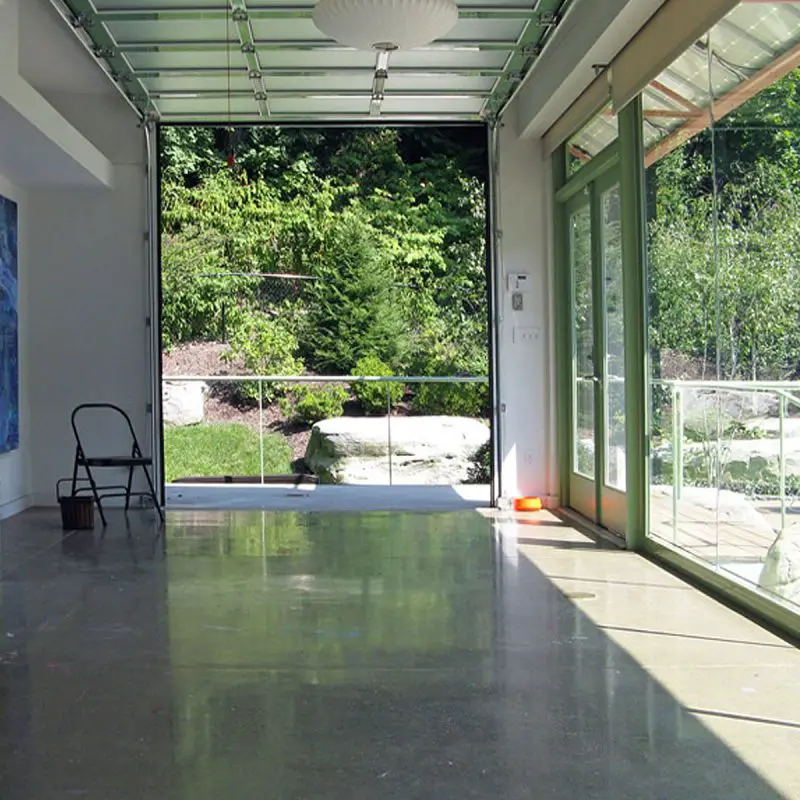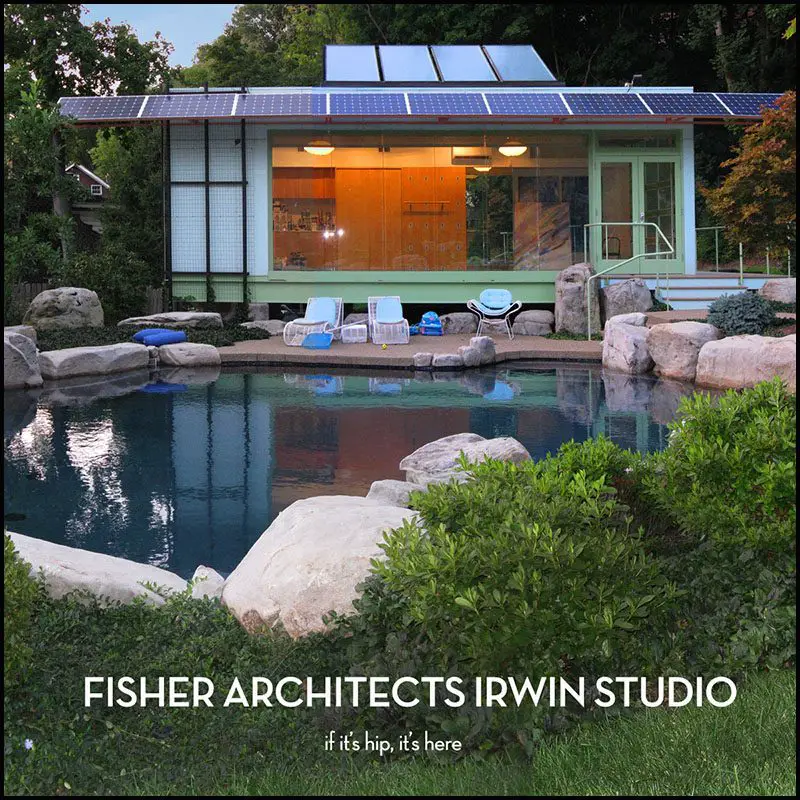The beautifully designed Irwin Studio by Pittsburgh’s Fisher Architecture is a functioning prototype that was built onsite, but designed in such a manner that future productions can be pre-fabricated and crane-delivered. The structure serves as a guest house –separated from the main house by a rock-surrounded, manmade pond and landscaping by Jim Lampl.
FISHER ARCHitecture Irwin Studio

The studio’s design takes full consideration of efficiency in both space and environmental impact. Despite being energy efficient, the model for future pre-fabricated homes features glass on 50% of its perimeter, providing an expansive view from the interior and lessening any chance of feeling closed in.


In addition to the feeling of openness as a result of the large glazed glass panels (that provide insulation), one end of the studio has an industrial-style door that pulls up to expose the studio’s above ground exterior patio.


The inside is clad in maple wood with a smart-looking murphy bed. The flooring is cement with radiant heating and the mirrored cabinets give the illusion of more space.


Sliding wood framed pocket doors with frosted glass inserts conceal a closet on one wall and a sunken tub with windows that provide a view to the outdoors on another.

The following text from the architect was so nicely written, I didn’t change a thing:
Most homes are like patients in a hospital, hooked up to wires and tubes for nourishment and air. If the wires and tubes fail, then so does the patient. Imagine for a moment that those wires and tubes can be unhooked. This is the idea we came to design for Steve and Andi Irwin when they asked FISHER ARCHitecture to design a guesthouse for a backyard lot adjacent to their Squirrel Hill home.
She wants to paint. He wants to exercise. They are both utility-bill-hating environmentalists. The net-zero concept came to seem like a natural project direction. We designed in SIPS walls, radiant floors, a solar hot water system, and PV panels, along with a revolutionary new radiant glass system by Blairsville based Greenheat. The radiant glass, which Frank Dlubak, the company owner, calls transparent insulation, may make it possible for the studio to become the world’s first zero energy prototype with 60% glazing! Ongoing monitoring by CMU professor, Nina Baird, will provide info on the effectiveness of these strategies.
The difference between this design and other Western Pennsylvania zero energy buildings is that this building is 100% designed to maximize the technologies that it is showcasing, which makes the technologies more affordable. This is not a “normal” house with “green” features. If the technologies are intrinsic to the design, they won’t be deleted when money runs short. Although the prototype was site built, we designed the studio so that future versions could be prefabricated in a shop and lowered into place with a crane.
The studio is highly contextual, with large windows that allow light in during Pittsburgh’s gray winter. It possesses an industrial look that shields the interior from Pittsburgh’s weather and is reflective of the city’s steel heritage. The project is filled with green materials and technologies that lower energy costs and are respectful of the environment. Yet the studio is filled with experiences that reconnect the inhabitants to the natural environment, featuring an open plan that responds to our generation’s need for flexible, efficient spaces.
That being said, our primary design intent was to clad the simple shed with the building’s green features, enabling the building shell to fit naturally into the Jim Lampl designed landscape. These elements then frame the articulate, warm interior studio experience behind the radiant glass.
The local woodlands are being displaced here as new homes are constructed. But 95% of this lot will remain untouched. Our plans include instructions to save every tree possible and to bury more than half the buildings area below grade. No fences will separate this home from its neighbors. Despite the home’s unconventional appearance, the neighbors support the construction because their walking paths will be preserved and their street views will remain unimpeded.
Ideas transcend style: We are reinforcing the building’s connection to nature by employing a variety of sustainable products and methods. The interior plan is flexible and open, resulting in light-filled spaces that can be used for different purposes as needs change. This is ‘bottom-up’ architecture, in which affordable, easy-to-build strategies are employed to create extraordinary experience.
Working from home is good for the planet. Just as important, the building concept celebrates nature by displacing attention from the house back to the woods. A building that enhances its occupants’ perception of natures beauty is one that will encourage all who visit to better respect the environment. – Eric Fisher
Landscaping: Jim Lampl
![]()
FISHER ARCHITECTURE
images and information courtesy of FISHER ARCHitecture






